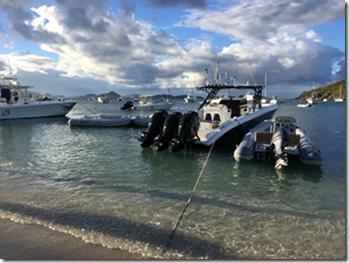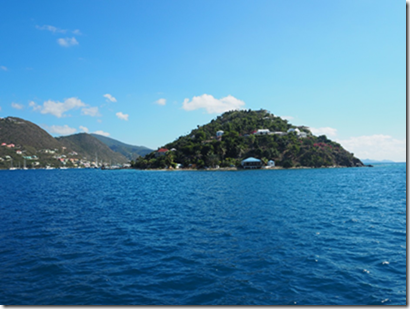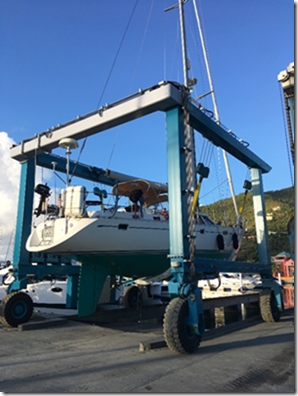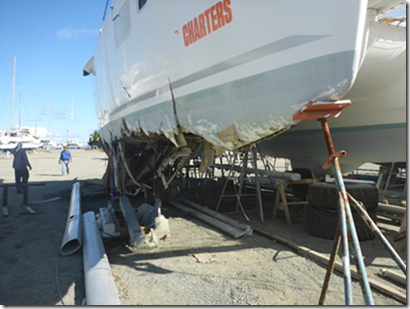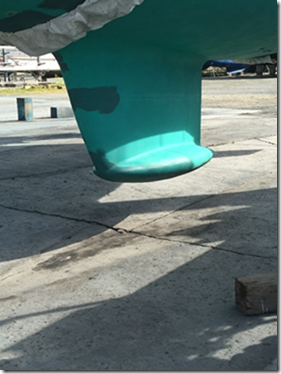18 Jan - Diving, flying, grinding and filling in the BVIs

|
18:23.86N 064:38.2W On this occasion (11 January) snorkelling at Jost van Dyke proved to be a non-starter due to a strong swell coming down from the east. Last time, Julie and I found that the rocks and shallows at the eastern end of Green Cay were a rich haven for marine life, but when Lizzie went in for a recce, she could not get close enough in without risk of being impaled on those rocks. So we had a cup of tea instead and relocated to White Bay at the western end of the island. The inshore anchorage at White Bay lies inside a stretch of coral reef with a couple of natural openings in it. It’s fairly shallow in there and there are mooring buoys at the eastern end, all full. The other end was crowded with charter catamarans who reduce the swinging room considerably, so we joined a superyacht in the quieter, deeper water where we could watch turtles swim past as we ate lunch. Overhead, frigate birds made the occasional swoop down to pick up a fish incautious enough to approach the surface, whilst pelicans noisily dive bombed a shoal amongst the coral.
White Bay, Jost van Dyke. We anchored towards the top left of the picture. Soggy Dollar is top right. The differences between fishing styles are fascinating: the frigate bird patrols at great height, swoops down and hardly breaks the surface of the water; the pelican circles at about thirty feet before diving vertically with a big splash; the booby cruises a couple of feet above the water and suddenly flops down as if he has had a total control failure. Of the three, the booby seems to do best. After lunch we ventured ashore. The western end of the beach is home to the ‘world famous’ Soggy Dollar beach bar, so named because you swim ashore and then leave your money to dry out on the bar whilst sampling their Painkiller cocktails, apparently invented there. It’s a good marketing line and clearly working well: there are a handful of beach bars here but only the Soggy Dollar was packed… Packed with people with unusually good teeth, immaculate tans and some exotic taste in minimalist beachwear. Not many locals, then (who have a fairly conservative approach to attire and a limited interest in alcohol).
Anchored stern-to, just off the beach, were a dozen centre console speedboats with an average of 900hp each who bring tourists across from the US Virgin Islands every day. We drank our obligatory Painkillers standing in the water and got talking to the skipper of one of these boats. He used to work at the eco-resort in Cinnamon Bay on St John (see our blog dated 19 April 2018) but when that close after Irma he bought himself a boat and now charged $750 a day (plus fuel) to get a taste of the Virgin Islands, snorkel, lunch at Cooper island (price not included) and a ‘wet’ at the Soggy Dollar. If there are seven or eight of you, it’s probably quite a fun day out and far better than sitting in one of the slightly drab-looking hotels on St Thomas. We walked and scrambled along the beach and cliffs to the eastern end of the Bay, which is much quieter. You can rent some quite swish-looking apartments here. Ran bought himself an obligatory t-shirt from the Soggy Dollar beach bar but we agreed that Julie’s Painkillers onboard were much better than the ‘originals’. Worth noting for a moment the bureaucracy that accompanies or constrains a holiday in these islands. You must have an ESTA if your flight routes you through the US – and that includes Puerto Rico and the US Virgin Islands. But you cannot enter the US Virgin Islands from the British Virgin Islands by private or charter boat unless you have a full US Visa. On the other hand, Americans can fly down to the US Virgins quite cheaply and complete some slightly dull but straightforward immigration paperwork when they arrive in the BVIs on their day trip. Brits or foreigners going the other way must enter the US via a commercial carrier. Rules is Rules, but the impact is interesting: there are almost no charter yachts in the US Virgin Islands and very few British holidaymakers, whilst the BVIs are full of Americans.
Anyway, on Friday we sailed around the western end of Tortola, past Sopers Hole, through Thatch Cut and into the Sir Francis Drake Channel, where we enjoyed a short beat to windward before anchoring off Water Point at Norman Island. Here, the snorkelling was at its best and we all enjoyed watching a small turtle wrestling with some unidentified delicacy in a crevice on the north side of The Indians. For about ten minutes until we broke off contact, he seemed fairly unperturbed by our presence and we were careful to maintain a decent distance and not shout ‘ooh look, there’s a turtle’ to all and sundry. Sadly, nobody briefs the hundreds of charter holidaymakers who come here on how to get the best out of this sort of experience – or perhaps they are too busy shouting at each other to listen? The Pirates Bight beach bar is one of the nicest venues in the BVIs and a great spot to watch the sun go down. Once you accept that these are New York or London prices, it’s good value too. Their Painkillers are better than the Soggy Dollar’s and before getting too wound up about the prices, it’s worth remembering that everything has to be brought in from outside here: I don’t think that the BVIs produce anything for themselves (except possibly chickens for home consumption - they run wild throughout the islands and act as an alarm clock at all hours of the night) - even the water comes from a desalination plant. I don’t think anybody lives full time on Norman Island.
Enjoying a Painkiller with Lizzie Saturday was Lizzie and Ran’s last full day, so we returned to Cooper Island for more guaranteed good snorkelling and a decent meal ashore in their restaurant. It’s also one of the few places where you can get ice cream in the BVIs: the US Virgins sell the stuff by the gallon, but for some obscure reason (given the hordes of charter boats) it’s relatively rare in the British sector. On the way north we stopped at Salt island, picked up a National Parks buoy and went snorkelling on the wreck of the RHONE. The water was clear and the visibility quite good; we were joined by some charter boat visitors and the matriarch of the group pointed down at the propeller shaft and asked ‘is that, like… the axle, then?’. The Cooper Island resort rents out paddleboards, but they are only affordable if you are a resident, so we ate ice cream instead. In the water, we saw a couple more turtles and some particularly exotic fish on the south side (the ocean side) of the rocks here. Tarpon, barracuda, rays and some large specimens of the usual rainbow array of reef fish. Sunday saw us back at Trellis Bay in our informal ‘airport departure lounge’ for lunch. Our good friend Verlie turned up with the stuff she has been storing for us over the Christmas period and as we sat down to eat, Lizzie announced that her flight to San Juan, Puerto Rico, had been brought forward four hours and she had missed it. This was the first leg of a three-part journey to Havana, Cuba (via Puerto Rico and Panama) so the implications were potentially serious. We decamped to the main airport terminal hastily and a difficult few hours unfolded. Ran was booked on a different flight to San Juan and there was room on his plane, but it was Sunday and nothing happens quickly here. Eventually, after handing over quite a lot of cash, she had a ticket, but at that point the airline staff queried whether she had an ESTA for entering the US (Puerto Rico is part of the US and you need a visa, even as a transit passenger). Providing evidence of this was problematic with limited internet connectivity on a Sunday afternoon. The departure gate shut and the aircraft prepared to depart with Ran onboard. In desperation, Lizzie applied to the US authorities for a new ESTA, at which point the computer turned around and said she already had one. Unsurprisingly perhaps, the airline staff then found the necessary information and she sprinted for the plane. Sadly her bag did not join her, but the good news is that she reached Havana on time that night. Amazingly, her bag joined her a couple of days later. Discussions with the travel company over competence are under way. Regardless, they enjoyed Cuba! We did not have time to hang around once Lizzie had disappeared. The boat was due to be lifted out of the water at 7am on Monday morning, so we motored round to Nanny Cay to spend the night in their marina and prepared the boat. The boatyard were expecting us and Escapade was clear of the water by 7:15 with the surveyor (organised by our insurance company at their cost) in attendance.
Lifting out at Nanny Cay Geoff Williams is my kind of yacht surveyor. He spent a full career at sea with elements of the South African merchant navy and Defence Force, driving their Antarctic Survey ship. He worked in France on the technical side of a boatbuilders specialising in composite technologies and catamarans, and he's had a yacht surveying business in Nanny Cay for many years. This is the charter capital of the world, so he’s seen more damage caused by groundings than most. And he’s a pragmatic, down to earth chap with a twinkle in his eye. We got on and established that the damage to Escapade was cosmetic and within my ability to repair. We realised our grounding was pretty minor when we compared our hull to that of a chartered Lagoon 450 catamaran that had grounded on a reef: the bottom was completely ripped out of one hull and she is genuinely written off as scrap. The difference in build quality answers some of the questions you see about why Oyster yachts are expensive… except that the Lagoon would set you back the same sort of money; but they are very different types of craft, so the comparison here is neither scientific nor particularly fair. However, the entrails revealed minimal structural reinforcement, poorly finished interior woodwork, cheap laminates and plywood, poorly secured electric cabling and pipework, not much paint, flimsy fittings… no thanks!
This is what can happen when you run a Lagoon catamaran onto a reef…
…and the result when we hit one with an Oyster… I spent the day smoothing the bottom of the lead keel where it was holding onto a couple of small rocks and deeply scratched. I used West Systems epoxy with a high-density filler to fill and fair the bulb and by the end of the day had the shape right and about half the depth filled and cured. The following day I finished the job with two further, fairly thin applications. Meanwhile Julie prepared other areas of antifouling that needed a touch up and polished the propeller. I regreased it, primed and antifouled the bare patches and we felt pleased with ourselves. We stayed overnight in the small hotel that is part of the marina and boatyard complex – living onboard without running water or electricity in a dusty boatyard would have been particularly miserable. The other people in the boatyard were very generous, lending us power tools (mine are all 220V and the BVIs use the US system of 110V) and keeping their spray paint from drifting over us. We had an interesting chat with Miles, the General Manager about hurricane damage. Here at Nanny Cay the cradles are pretty robust and the boats were well secured. But the majority left their masts up and in the extraordinary winds that came, the arrangement was put under enormous loading. Once the mast broke, pressure was released and the boat generally survived with relatively minor damage – upper deck fittings carried away by the falling debris, that sort of thing. On some boats, the cradles actually punched through the hulls. When the tidal surge came, the boatyard was under about five feet of water and some of the catamarans, sitting on low blocks, floated up sufficiently for the blocks to escape – and damage to occur when the waters subsided. If we had left Escapade there, I think she would probably have been okay if we had removed the mast and ensured that the cradles were placed accurately against the strongest parts of a very strong hull… On the Wednesday morning my work was done so we refloated the boat, restowed the remaining spare gear that we had landed for Christmas, said our goodbyes to a fine bunch of staff at Nanny Cay and returned to Road Town to clear Customs and visit the supermarket. We had one day left on our BVI visitors permits…
Repairs complete. The paint goes a uniform colour on immersion in salt water. There was no crack at all around the keel to hull joint, but we ground it back just in case. |

